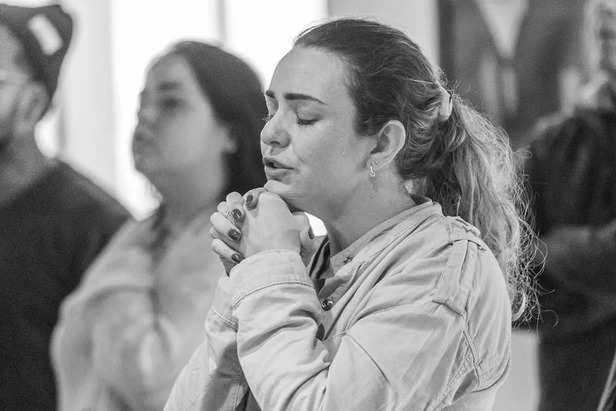Who Are You Without SUFFERING? The Gita’s Answer Will Transform Your Life
Nidhi | Feb 28, 2025, 13:11 IST
( Image credit : Pexels, Timeslife )
Do we unknowingly define ourselves through our pain? The Bhagavad Gita challenges us to look beyond suffering and rediscover our true identity. This article explores why we cling to struggles, how attachment to pain shapes our self-perception, and what the Gita teaches about transcending suffering to find inner peace. Dive into timeless wisdom that reveals who you are beyond your wounds.
Pain is a shadow we mistake for ourselves. We wear our suffering like an old cloak, familiar yet heavy, believing it defines us. But the Bhagavad Gita whispers a deeper truth: You are not your pain. Your existence is not measured by sorrow but by the infinite essence beyond it.
The Gita does not ask us to ignore pain but to see it for what it is—a fleeting storm, not the sky itself. It invites us to step beyond suffering and rediscover the self that exists beyond wounds. So, why do we cling to pain? And who are we when we let it go?
Let’s uncover the wisdom of the Gita on transcending struggle.

“नासतो विद्यते भावो नाभावो विद्यते सतः।”
"That which is unreal never comes into existence, and that which is real never ceases to be." (Bhagavad Gita 2.16)
We often introduce ourselves through our struggles: “I am someone who has suffered loss,” “I am someone who was betrayed.” But the Gita reminds us that the self—Atman—remains untouched by sorrow. Pain is an experience, not an identity. The more we define ourselves by suffering, the harder it is to see who we truly are.
Contemplate: If your suffering vanished today, who would you be? That answer reveals your real essence.

“यमो हि सर्वम् दुःखायम्श्नम्।”
"The mind attached to sorrow cannot see beyond it."
Why do we hold onto pain? Because it gives us a narrative. It becomes a well-worn story we tell ourselves. The Gita teaches that attachment, even to suffering, binds us. Pain can be addictive—not because it feels good, but because it feels known. But growth lies in releasing the known and stepping into possibility.
Ask Yourself: If you were free of your suffering, what could you create instead?

“कर्मण्येवाधिकारस्ते मा फलेषु कदाचन।”
"You have the right to work, but never to the fruits of your work." (Bhagavad Gita 2.47)
Pain often comes from expectations—wanting life to be fair, wanting love to be reciprocated, wanting our efforts to yield desired results. The Gita reminds us that struggle is part of our karmic journey, shaping us in ways we cannot yet understand. Our role is to act with sincerity, detached from whether things go our way or not.
Shift Perspective: Instead of asking “Why me?” ask “What is this pain shaping me into?”

“यो न हृष्यति कर्मफलम्।”
"He who is free from attachment, fear, and anger is truly liberated." (Bhagavad Gita 5.28)
What hurts is not the experience itself, but our resistance to it. A loss is painful, but clinging to the idea of “what should have been” is what deepens suffering. The Gita teaches that freedom lies in detachment—not in apathy, but in the wisdom that all things are impermanent.
Practice Letting Go: Identify one painful memory you replay in your mind. Imagine placing it on a river and watching it drift away. Feel the lightness that follows.

“मनेवा मानस्मिता शिव येतस्य शुभम्।”
"As a man thinks, so he becomes." (Bhagavad Gita 6.5)
Our thoughts shape our reality. The more we dwell on suffering, the more power it has over us. The Gita encourages sattvic (pure) thinking, reminding us that where attention goes, energy flows. Pain lingers only when the mind feeds it.
Reframe: When a painful thought arises, replace it with a question—“What is this moment teaching me?” This shifts the mind from suffering to wisdom.

“सर्वधर्मान् परित्यज्य मामेकं शरणम्।”
"Surrender unto Me alone, and I shall deliver you from all sins." (Bhagavad Gita 18.66)
True relief comes when we surrender—not in defeat, but in trust. The Gita teaches that when we stop resisting life’s flow and surrender to the universe, God, or inner wisdom, suffering dissolves. We realize that nothing was ever truly lost; everything is part of a greater unfolding.
Trust the Process: What if, just for today, you believed that everything is happening exactly as it should?

Pain is not a destination; it is a passage. The Bhagavad Gita reminds us that suffering is a fleeting illusion, but the self is eternal. We are not defined by our wounds, but by the awareness that watches them heal.
The path to freedom begins with recognizing that pain is not our master but our teacher. When we step beyond our suffering, we discover a self that is whole, resilient, and luminous. The Gita urges us to embrace this truth—not as a mere philosophy, but as a way of living.
So, who are you without your pain? The Gita whispers—You are boundless, untouched, infinite. You are, and always have been, free.
The Gita does not ask us to ignore pain but to see it for what it is—a fleeting storm, not the sky itself. It invites us to step beyond suffering and rediscover the self that exists beyond wounds. So, why do we cling to pain? And who are we when we let it go?
Let’s uncover the wisdom of the Gita on transcending struggle.
1. Pain is Not Your True Identity

Sad
( Image credit : Pexels )
“नासतो विद्यते भावो नाभावो विद्यते सतः।”
"That which is unreal never comes into existence, and that which is real never ceases to be." (Bhagavad Gita 2.16)
We often introduce ourselves through our struggles: “I am someone who has suffered loss,” “I am someone who was betrayed.” But the Gita reminds us that the self—Atman—remains untouched by sorrow. Pain is an experience, not an identity. The more we define ourselves by suffering, the harder it is to see who we truly are.
Contemplate: If your suffering vanished today, who would you be? That answer reveals your real essence.
2. The Comfort of Familiar Pain

Pain
( Image credit : Pexels )
“यमो हि सर्वम् दुःखायम्श्नम्।”
"The mind attached to sorrow cannot see beyond it."
Why do we hold onto pain? Because it gives us a narrative. It becomes a well-worn story we tell ourselves. The Gita teaches that attachment, even to suffering, binds us. Pain can be addictive—not because it feels good, but because it feels known. But growth lies in releasing the known and stepping into possibility.
Ask Yourself: If you were free of your suffering, what could you create instead?
3. Karma and the Purpose of Struggles

Struggle
( Image credit : Pexels )
“कर्मण्येवाधिकारस्ते मा फलेषु कदाचन।”
"You have the right to work, but never to the fruits of your work." (Bhagavad Gita 2.47)
Pain often comes from expectations—wanting life to be fair, wanting love to be reciprocated, wanting our efforts to yield desired results. The Gita reminds us that struggle is part of our karmic journey, shaping us in ways we cannot yet understand. Our role is to act with sincerity, detached from whether things go our way or not.
4. The Trap of Emotional Attachment

Freedom
( Image credit : Pexels )
“यो न हृष्यति कर्मफलम्।”
"He who is free from attachment, fear, and anger is truly liberated." (Bhagavad Gita 5.28)
What hurts is not the experience itself, but our resistance to it. A loss is painful, but clinging to the idea of “what should have been” is what deepens suffering. The Gita teaches that freedom lies in detachment—not in apathy, but in the wisdom that all things are impermanent.
5. The Mind’s Role in Amplifying Pain

Sad Women
( Image credit : Pexels )
“मनेवा मानस्मिता शिव येतस्य शुभम्।”
"As a man thinks, so he becomes." (Bhagavad Gita 6.5)
Our thoughts shape our reality. The more we dwell on suffering, the more power it has over us. The Gita encourages sattvic (pure) thinking, reminding us that where attention goes, energy flows. Pain lingers only when the mind feeds it.
6. Surrender: The Ultimate Freedom from Pain

Pray
( Image credit : Pexels )
“सर्वधर्मान् परित्यज्य मामेकं शरणम्।”
"Surrender unto Me alone, and I shall deliver you from all sins." (Bhagavad Gita 18.66)
True relief comes when we surrender—not in defeat, but in trust. The Gita teaches that when we stop resisting life’s flow and surrender to the universe, God, or inner wisdom, suffering dissolves. We realize that nothing was ever truly lost; everything is part of a greater unfolding.
You Are Infinite, Not Broken

Eternal
( Image credit : Pexels )
Pain is not a destination; it is a passage. The Bhagavad Gita reminds us that suffering is a fleeting illusion, but the self is eternal. We are not defined by our wounds, but by the awareness that watches them heal.
The path to freedom begins with recognizing that pain is not our master but our teacher. When we step beyond our suffering, we discover a self that is whole, resilient, and luminous. The Gita urges us to embrace this truth—not as a mere philosophy, but as a way of living.
So, who are you without your pain? The Gita whispers—You are boundless, untouched, infinite. You are, and always have been, free.
